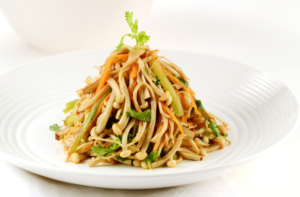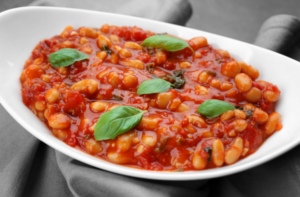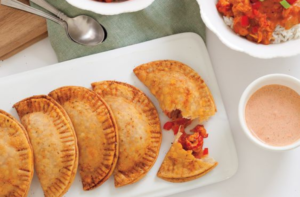Introduction to Seafood Mushrooms
Seafood mushrooms, also known as enoki mushrooms, golden needle mushrooms, or winter mushrooms, are a delightful and versatile ingredient beloved in various cuisines, particularly in Asian cooking. These mushrooms are characterized by their long, slender stems and small, delicate caps, resembling a cluster of thin white needles.
One of the most intriguing aspects of seafood mushrooms is their subtle, slightly sweet flavor that carries a hint of crispiness when cooked. This unique taste profile makes them an excellent addition to soups, stir-fries, and salads. They are not only valued for their taste but also for their health benefits, including being low in calories and rich in nutrients like vitamins B and D, antioxidants, and dietary fiber.
Seafood mushrooms have a distinctive texture that holds up well in cooking, which is why they are frequently used as a garnish in noodle dishes or as a major component in broths and hot pots. Their ability to absorb flavors while adding a crunchy texture makes them a favorite among chefs looking to add depth and interest to their dishes. Whether simmered gently in a flavorful broth or quickly tossed in a hot stir-fry, seafood mushrooms bring a unique element to the culinary world.
Ingredients Needed for Seafood Mushroom Recipes
Cooking with seafood mushrooms allows for a variety of dishes, each requiring its own set of ingredients. Here’s a breakdown of essential and optional ingredients, including suggested quantities to help you get started.
Essential Ingredients
- Seafood Mushrooms: 200 grams, cleaned and trimmed
- Garlic: 2 cloves, minced or finely chopped
- Soy Sauce: 2 tablespoons, for a rich umami flavor
- Oil: 2 tablespoons, vegetable or sesame, for cooking

Optional Ingredients
- Chilies: 1-2 fresh red or green chilies, sliced for heat (adjust based on your spice preference)
- Herbs: A handful of scallions, cilantro, or parsley, chopped for freshness
- Spices: 1 teaspoon of ginger, minced; a pinch of black pepper or a sprinkle of sesame seeds for extra flavor
Substitutions and Variations
Here are some common substitutions to tailor your seafood mushroom dishes to different dietary needs or based on what you have in your pantry.
- Gluten-Free Soy Sauce: Substitute regular soy sauce with a gluten-free variant, maintaining the 2 tablespoons measurement.
- Coconut Aminos: Replace soy sauce with an equal amount of coconut aminos if avoiding soy, which also lowers the sodium content.
- Walnut or Peanut Oil: Use in place of sesame oil for a nutty flavor, measure for measure, unless allergies are a concern.
- Reduced Sodium: Cut down the soy sauce to 1 tablespoon and add more herbs and spices to compensate for flavor when catering to a low-sodium diet.
These quantities and substitutions offer a basic guideline but feel free to adjust them based on the specific recipes and your taste preferences. Each adjustment can help tailor the dish to better suit dietary restrictions and flavor profiles, making your seafood mushroom creations both delicious and versatile.
Step-by-Step Cooking Instructions for a Basic Seafood Mushroom Dish
Instructions:
- Prepare the Ingredients: Begin by prepping your mushrooms, making sure they are clean and trimmed. Mince the garlic and if using, slice the chilies and chop your herbs.
- Heat the Oil: In a large skillet or wok, heat the vegetable oil over medium-high heat. Make sure the oil is hot before adding other ingredients to ensure a good sear.
- Sauté Garlic: Add the minced garlic to the hot oil, stirring constantly to prevent it from burning. Cook until the garlic is golden and fragrant, about 1 minute.
- Add Mushrooms: Increase the heat to high and add the seafood mushrooms to the skillet. Stir-fry quickly to mix with the garlic and coat evenly in oil.
- Season the Dish: Pour the soy sauce over the mushrooms, stirring to evenly distribute. Add sliced chilies now if you want some heat.
- Cook to Perfection: Continue to cook, stirring frequently, until the mushrooms are tender and the edges begin to crisp slightly, about 3-5 minutes.
- Garnish and Serve: Remove from heat, toss in chopped cilantro for freshness, and serve immediately. Enjoy your seafood mushrooms as a delicious side dish or incorporate them into a larger meal.

Tips for Perfect Cooking
- Don’t Overcook: Seafood mushrooms are delicate. Overcooking them can make them slimy or overly soft. Watch the heat and timing carefully to maintain their crisp texture.
- High Heat for Stir-frying: Cooking quickly over high heat helps to sear the mushrooms and lock in flavors without losing texture.
- Prep Ingredients Beforehand: Having all your ingredients ready before you start cooking is essential in stir-frying, as the cooking process is fast and requires immediate addition of ingredients.
- Adjust Seasonings: Depending on the brand of soy sauce, you might need to adjust the quantity to balance the saltiness. Start with less; you can always add more.
- Use Fresh Garlic: For the best flavor, use fresh garlic rather than garlic powder or pre-minced varieties.
Following these steps and tips, you can ensure your seafood mushrooms are cooked to perfection, bringing out their best flavor and texture. Enjoy experimenting with this unique ingredient in your kitchen!
Serving Suggestions for Seafood Mushrooms
Seafood mushrooms are exceptionally versatile and can enhance various dishes with their delicate texture and flavor. For a simple side, stir-fry them with garlic and soy sauce, perfect alongside Grilled Steak or Baked Salmon. They also add an earthy dimension to Miso Soup. Incorporate them into noodle dishes like Beef Ramen or pasta such as Spaghetti Aglio e Olio for a delightful texture contrast. They’re also great in rice dishes like Mushroom Risotto or Seafood Mushroom Fried Rice, absorbing flavors beautifully. For an appetizing starter, top Mushroom Bruschetta with sautéed seafood mushrooms or include them in Summer Green Salads for a crisp touch. Alternatively, create a gourmet appetizer by stuffing them with a mixture of herbs and cheese, serving as Stuffed Seafood Mushrooms, or thread them on skewers with vegetables for Grilled Mushroom and Veggie Kebabs. Each of these serving suggestions allows the mushrooms to shine, enhancing the overall flavor and texture of your meals.
Nutritional Information on Seafood Mushrooms
Seafood mushrooms, commonly known as enoki mushrooms, offer a wealth of nutritional benefits that make them a valuable addition to a healthy diet. These slender, crisp mushrooms are not only low in calories but also rich in essential nutrients.
- Low in Calories: Seafood mushrooms are ideal for weight management due to their low caloric content, making them a great addition to any diet.
- Rich in Dietary Fiber: They are a good source of dietary fiber, which helps in improving digestion and maintaining a healthy gut.
- Vitamins and Minerals: Seafood mushrooms are rich in several important nutrients, including Vitamin B3 (niacin), which is crucial for converting food into energy and maintaining healthy skin and nerves. They also contain Vitamin D, rare in non-animal products, which is vital for bone health and immune function.
- Antioxidants: These mushrooms contain antioxidants like selenium, which helps to reduce oxidative stress and inflammation in the body.
Preservation and Storage of Seafood Mushrooms
Proper storage is essential to keep seafood mushrooms fresh and extend their shelf life, whether fresh or cooked.
Fresh Seafood Mushrooms
- Refrigeration: Keep them in the fridge, ideally in their original packaging or a paper bag to allow air circulation and reduce moisture.
- Handling: Clean mushrooms just before use to avoid premature spoilage.
Cooked Seafood Mushrooms
- Cooling: Let cooked mushrooms cool to room temperature before storing.
- Containers: Use airtight containers to store them in the refrigerator, where they can last up to 5 days.
Freezing
- Preparation: Blanch fresh mushrooms before freezing to preserve texture.
- Freezing Technique: Freeze on a tray before transferring to a freezer bag for easy portioning.
These tips will help ensure your seafood mushrooms stay fresh and tasty for both immediate and future use.



